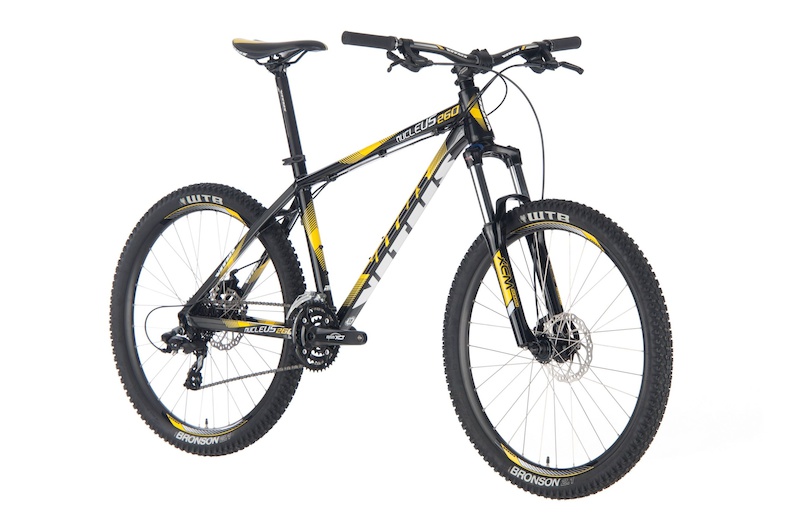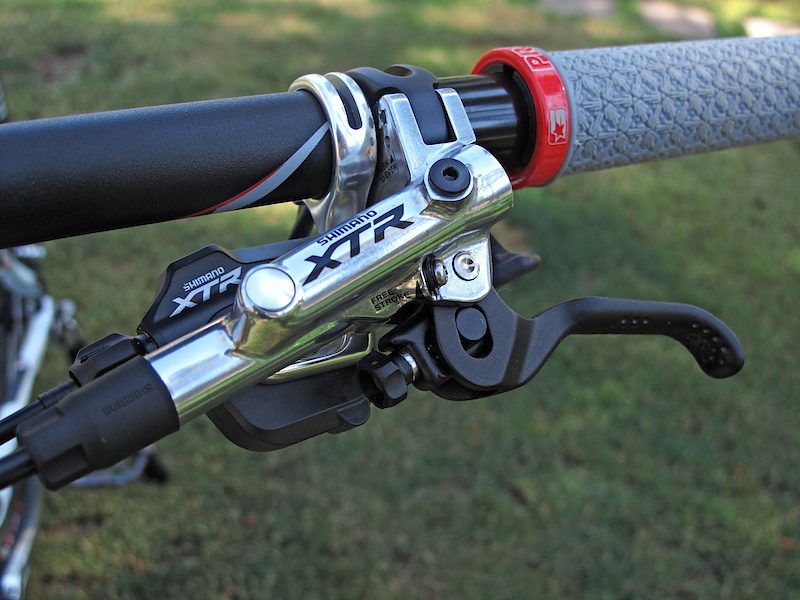Ask Pinkbike - Shimano XTR Brake Tips, One-By Chainring Choices and the Wrong Slopestyle Bike
Here at Pinkbike we get inundated with all kinds of questions, ranging from the basic "Can I have stickers" to more in-depth, soul searching types of queries like if you should pop the question or what to name your first child. Ask Pinkbike is an occasional column where we'll be hand picking and answering questions that have been keeping readers up at night, although we'll likely steer clear of those last two and keep it more tech oriented.
Tricks for XTR Trail Brakes
Question: Pinkbike user monkeyc asked this question in the Mechanic's Lounge forum: I've got myself a new bike that has come with a set of Shimano XTR Trail brakes and I'd like to know how to adjust the brake pads closer to the discs. Does anyone know how?
 | The general consensus is that your new bike's XTR Trail brakes are the best in the biz, and looking at how often they're spec'd on dream builds confirms that they're the brakes chosen most often when money isn't a concern. They are not perfect, however, as you've discovered, with a lack of any sort of effective bite point adjustment that most of their competition sports. Most other high-end brake systems include a dial that allows the user to adjust the amount of free stroke that the lever has before the pads make contact with the rotor, usually offering a massive range that will allow the lever to either pull to the grip or have almost no pull at all, but the small philips screw that is supposed to control this function on the XTR Trail's has almost no effect at all. It's a strange ball-drop from Shimano on an otherwise near perfect component, but there is a go around that you hit on that allows riders to tune the free: artificially moving the brake's pistons out of the caliper. Advancing the pistons is as simple as removing the wheel and pulling the brake lever just enough to push the pistons out a touch, and because the pads don't make contact with the rotor they will tend to not retract back completely to their resting position. And now that they're sitting out of their bores slightly further - we're talking about a millimeter or less on each side - the pads are obviously closer to the rotor and don't need to travel as far to make contact. They key is to take your time when pulling the lever when the wheel isn't in place, as going too far can mean that you'll have excessive brake rub and need to carefully push them back in, or even manage to force one or both of them right out of their bores - that's a worst case scenario. All you're doing is moving brake fluid from the brake's reservoir into action, with there being enough volume in the system to account for the small amount of fluid that you're displacing, but don't be surprised if that fluid returns to the reservoir over time and your brake begins to feel like it did before you advanced the pistons. It's for this reason that your best bet for consistent performance in the long run is to first advance the pistons and make sure that you like the amount of free stroke that you have at the lever, and then bleed the system with the pistons pushed slightly out. Doing this will creates a brake that will not only have the amount of free stroke that you like, but also feel predictable. - Mike Levy |
The XTR Trail brakes are oh so close to being perfect, but a simple trick can unleash their full potential.
Chainring Choice for a One-By Drivetrain
Question: Nialo asks in the All-Mountain, Enduro & Cross-Country forum: I'm interested to hear what is the best size chainring to use with a 1x10, or a 1 x 11 for that matter. I have been hearing lots of noise, but nothing from actual users.
 | The short answer is that a SRAM 1 X 11 with a 32 tooth chainring is a near-perfect gear spread for aggressive trail riding on a 26-inch-wheel bike - up or down. If you ride a 29er or a 27.5-inch-wheel bike with a 1 X 11, you'll want to drop the chainring size to 30, even 28 teeth to compensate for the extra distance the bike travels with each revolution of the larger wheel. SRAM's eleven speed cassette, with its ten-tooth high and 42-tooth low gear provides a wider, more useful range of gearing than a standard 11 X 36, ten-speed cassette can offer. Converting to a 1 X 10 drivetrain forces you to compromise between top speed and a good climbing gear. Most err towards a climbing gear, because climbing hurts all the time and descending, not so much. Your chainring selections will be limited to the BCD (bolt circle diameter) of your crankset. Assuming that you will be converting a double or triple crankset with the common, 104-millimeter BCD, you will be using the inside "middle-ring" position of the crank spider, which restricts the smallest available sprockets to either a standard 32 or a special 30-tooth sprocket. If you have a 26-inch-wheel, medium-weight trailbike with an 11 by 36-tooth, ten-speed cassette, your best option is a 32 tooth chainring, because it gives you a decent top speed, with a low enough granny gear to climb steeps for a reasonable distance. Choose s 30-tooth ring if you need a better climbing gear. If you need lower gearing than a 30 tooth can offer, and are lucky to own a bike with a SRAM or Truvativ GXP crankset, you can remove the spider and replace it with a direct-mount chainring. Direct-mount sprockets are sold in even numbers from 26 through 48 teeth, so you'll be able to match your drivetrain to your leg power. Unfortunately, those who ride 29ers and mid-sized 27.5-inch bikes and are stuck with a 104 BCD crankset will need World Cup legs to power a 30 x 36 up a tough climb. In this case, a 40 or 42-tooth cog can be installed on select Shimano and SRAM ten-speed cassettes to achieve the proper gear spread. Those who are converting their multi-chainring drivetrains to a one-by should be warned to use chainrings with a narrow-wide tooth profile to keep the chain on and, unless your rear derailleur is the new clutch type, you will need at least an upper guide to ensure that the chain stays put when you are bouncing down the trail in a "cross-over" gear selection. - RC |

Pivot's Mach 5.7 with a Shimano XTR 104 BCD crankset converted to a 1 X 10 with a 32-tooth MRP chainring and a Lopes SL chain guide, and a OneUp 42-tooth cassette cog.
Vitus Nucleus for Slopestyle?
Question: PB user xOriginz asked the following in the Freeride and Slopestyle forum: I'm starting out in freeride/slopestyle and or downhill but I'm on a low budget and I'm looking at buying this hardtail. It's a Vitus Nucleus 260. I don't think it's very common, but it's in my price range, got all the right specs and looks the part, so I'm asking for some opinions.
 | Although the Vitus may work fine for a beginning mountain biker, I wouldn't recommend it for any sort of aggressive riding. Along with the components not being designed to handle the abuse you'll be dishing out, the bike's geometry isn't designed for that style of riding either. You'll want something with a lower standover height to give you room to maneuver in the air, and extra short chainstays to help you pop off the lip of jumps. I'd try to figure out exactly what type of bike you're looking for, rather than searching for the elusive (and non-existent) $500 do-it-all slope/freeride/DH machine. It's a matter of choosing the right tool for the job, and if you're interested more in jumping and learning tricks as opposed to getting down the gnarliest runs you can find, I'd suggest a used dirt jumper. Take a look at the Pinkbike Buy and Sell, and you should be able to find a number of options in the $500-$700 range that will be able to take a beating and keep on rolling. Something from Specialized's P series, or Norco's Ryde series could be good options. A singlespeed, hardtail dirt jumper will help you gain skills that you can transfer to a full suspension bike when your budget allows. If you have dreams of Red Bull Rampage style hucking or full-on downhill riding, the dirt jumper isn't going to be the best tool, but it will still be better than the Vitus, at least from a durability standpoint. Unfortunately, for freeriding or downhill your price range should probably be a little higher - it might be time to start thinking of ways to scrounge up some more cash in order to afford a downhill worthy rig. - Mike Kazimer |

The Vitus Nucleus isn't going to be the best option for riders looking to get into slopestyle riding.
Have some unresolved tech questions? Jump in the Pinkbike Forum and we'll look to answer it for next time.
Author Info:
Must Read This Week
Sign Up for the Pinkbike Newsletter - All the Biggest, Most Interesting Stories in your Inbox
PB Newsletter Signup



 Member since Jul 22, 2013
Member since Jul 22, 2013
Just sayin...
Strongly disagree, I have a N/W chainring, no chainguide and a (non-clutch) x9 short-cage rear derailluer, and I only loose my chain when I smash the bike into asphalt. I haven't lost it on a trail yet. This is literally 10x less often than when I had a front derailluer, god front derailluers suck. If a 3x drivetrain was OK for you, then you'll probably be good without buying an upper chainguide. And a "cross-over" gear selection on a 1x drivetrain doesn't make sense, I think you mean a gear selection with a bad chainline.
I have essentially done exactly the same thing to my Zee lever (on m810 caliper). I did it by forcing a tiny bit of extra oil in to the system with a syringe during bleeding, but it seems to me that this will achieve exactly the same thing as advancing the pistons, then re-topping up the reservoir. I am aware that as the pads wear the lever pull will grow, but am happy to add a bit more oil when this becomes noticeable.
My question is this....As far as I can work out this set up means the slave pistons will start moving before the reservoir port is closed off by the master piston, or in the worst case scenario, the pads will actually contact the disc and start building pressure in the system before the reservoir port is closed. My worry is this will cause the reservoir and its relevant seals to become a load bearing part of the system. Although I have had no issues so far, it does bug me slightly, and seeing as it has come up here, I thought I'd take the opportunity to ask for anyone elses views or input on the topic.
So... any comments are welcome really, as long as they aren't along the lines of "buy another brake" cos thats not gonna happen.
also i wouldn't use the fluid to force the pistons out and pads closer in the bleed cycle, it seems like a difficult way to get to the position you want. advancing them with the brake lever itself (which pushes fluid from the reservoir down to the piston) uses the system in the manner it was intended, rather than trying to create pressure on the reservoir port by pushing fluid from the caliper and back.
Never tried it myself.
This trick works, but you have to do this very often. If you want to reduce the free stroke forever, you need to change the caliper's seals for ones with less stroke.
Long story short the narrow wide chain ring does a bigger difference than the clutch derualer unless you're worried about noise. Or you could just get a chain guide
Sorry @spykr I accidentally negative propped you when I tried to reply.
While this limits your top end a hair, be honest with yourself--you spend a LOT more time in your granny gear than your highest gear.
I have essentially done exactly the same thing to my Zee lever (on m810 caliper). I did it by forcing a tiny bit of extra oil in to the system with a syringe during bleeding, but it seems to me that this will achieve exactly the same thing as advancing the pistons, then re-topping up the reservoir. I am aware that as the pads wear the lever pull will grow, but am happy to add a bit more oil when this becomes noticeable.
My question is this....As far as I can work out this set up means the slave pistons will start moving before the reservoir port is closed off by the master piston, or in the worst case scenario, the pads will actually contact the disc and start building pressure in the system before the reservoir port is closed. My worry is this will cause the reservoir and its relevant seals to become a load bearing part of the system. Although I have had no issues so far, it does bug me slightly, and seeing as it has come up here, I thought I'd take the opportunity to ask for anyone elses views or input on the topic.
So... any comments are welcome really, as long as they aren't along the lines of "buy another brake" cos thats not gonna happen.
Chainring: Race Face Narrow/Wide 34T
Chain guide: MRP AMg (Or modify a G2 or G3 by carefully taking a hack saw to the lower pulley section. I've done it and it works.)
Cassette: X9 11-36T
Derailleur: Saint
Chain: XX1
This give enough of a high gear for sprinting on trails and bike parks (not fire roads) and just enough of a low gear to make it up steep lung burning accents. I'm not a pro racer by any means so I'd say the intermediate 26" All-mountain rider would be fine with this setup. I would only go to a bigger chainring (36T specifically) if I did the 42T cog conversion but I don't think the short cage derailleur would like that.
A note on the narrow/wide ring. Brands like Race Face and e13 don't have the same tooth profile as SRAM and do not hold the chain on as well even with a clutch derailleur. I dropped mine several times on really rough stuff before putting on an upper guide (and yes, I tried different chain lengths). SRAM X1, X01, XX1 teeth are wider and flatter on the tip when looked at from the side. It's apparently not just about alternating tooth thickness, it's also about tooth profile. Other brands like Fouriers, Hope, Wolftooth, Blackspire, and Praxis appear to have a very similar tooth design to SRAM and if I were to buy a new chainring, I would try one from them instead.
m.pinkbike.com/photo/9392772
narrow wide not compatible with odd tooth spacing? Trying to get my head around that